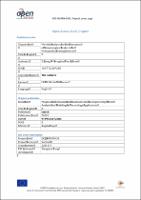Chapter 3 Wavelet Analysis for the Extraction of Morphological Features for Orthopaedic Bearing Surfaces
Author(s)
Jiang, X.
Zeng, W.
Scott, Paul J.
Collection
European Research Council (ERC)Language
EnglishAbstract
Surface texture is one of the most critical factors and important functionality indicators in the performance of high precision and nanoscale devices and components. The functions
that have been identified in various studies include wear, friction, lubrication, corrosion,
fatigue, coating, paintability, etc. [1-3]. It is also reported that the wear rates of surfaces in
operational service is determined by roughness, waviness and the multi-scalar topographic
features of a surface, such as random peaks/pits and ridges/valleys. These functional
topographical features will impact directly on wear mechanics and physical properties of a
whole system, such as hip joint replacement system in bioengineering [4-9]. For example,
during functional operation of interacting surfaces, peaks and ridges will act as sites of high
contact stresses and abrasion; consequently wear particles and debris will be generated by
such surface topographical features, whereas the pits and valleys will affect the lubrication
and fluid retention properties. In this situation, a vitally important consideration for
functional characterisation must be the appropriate separation of the different components
of surfaces, which is not only to extract roughness, waviness and form error, but should also
be extended to all multi-scalar topographical events over surfaces.
Keywords
orthopaedic bearing surfaces; orthopaedic bearing surfaces; Biorthogonal wavelet; Cutoff frequency; Discrete wavelet transform; Lifting scheme; Low-pass filter; Wavelet; Wavelet transform; WavinessDOI
10.5772/20728OCN
1030817225Publisher
InTechOpenPublisher website
https://www.intechopen.com/Publication date and place
2011Grantor
Classification
Science: general issues


 Download
Download